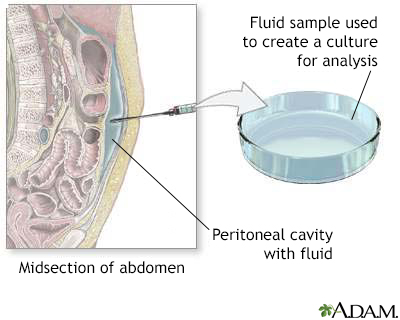Peritoneal fluid culture
Culture - peritoneal fluid
Peritoneal fluid culture is a laboratory test performed on a sample of peritoneal fluid. It is done to detect bacteria or fungi that cause infection (peritonitis).
Peritoneal fluid is the fluid in the peritoneal cavity, a space between the wall of the abdomen and the organs inside.
Images

How the Test is Performed
A sample of peritoneal fluid is needed. This sample is obtained using a procedure called an abdominal tap (paracentesis).
A sample of fluid is sent to the laboratory for Gram stain and culture. The sample is checked to see if bacteria grows.
How to Prepare for the Test
Empty your bladder before your abdominal tap procedure.
How the Test will Feel
A small area in your lower abdomen will be cleaned with germ-killing medicine (antiseptic). You may also receive local anesthesia. You will feel pressure as the needle is inserted. If a large amount of fluid is withdrawn, you may feel dizzy or lightheaded.
Why the Test is Performed
The test is done to find out if there is an infection in the peritoneal space.
Normal Results
Peritoneal fluid is a sterile fluid, so normally no bacteria or fungi are present.
What Abnormal Results Mean
The growth of any microorganism, such as bacteria or fungi, from peritoneal fluid is abnormal and indicates peritonitis. If you have cirrhosis and bacteria are found in your peritoneal fluid, you may have spontaneous bacterial peritonitis (SBP). This is a life-threatening infection that must be treated with antibiotics. If your peritonitis is from another condition, your provider will treat it and look for the cause.
Risks
There is a small risk of the needle puncturing the bowel, bladder, or a blood vessel in the abdomen. This may result in bowel perforation, bleeding, and infection.
Considerations
The peritoneal fluid culture may be negative, even if you have peritonitis. The diagnosis of peritonitis is based on other factors, in addition to the culture.
References
Bush LM, Levison ME. Peritonitis and intraperitoneal abscesses. In: Bennett JE, Dolin R, Blaser MJ, eds. Mandell, Douglas, and Bennett's Principles and Practice of Infectious Diseases. 9th ed. Philadelphia, PA: Elsevier; 2020:chap 74.
Solà E, Ginès P. Ascites and spontaneous bacterial peritonitis. In: Feldman M, Friedman LS, Brandt LJ, eds. Sleisenger and Fordtran's Gastrointestinal and Liver Disease. 11th ed. Philadelphia, PA: Elsevier; 2021:chap 93.
BACK TO TOPReview Date: 10/30/2024
Reviewed By: Jenifer K. Lehrer, MD, Gastroenterologist, Philadelphia, PA. Review provided by VeriMed Healthcare Network. Also reviewed by David C. Dugdale, MD, Medical Director, Brenda Conaway, Editorial Director, and the A.D.A.M. Editorial team.

Health Content Provider
06/01/2025
|
A.D.A.M., Inc. is accredited by URAC, for Health Content Provider (www.urac.org). URAC's accreditation program is an independent audit to verify that A.D.A.M. follows rigorous standards of quality and accountability. A.D.A.M. is among the first to achieve this important distinction for online health information and services. Learn more about A.D.A.M.'s editorial policy, editorial process and privacy policy. A.D.A.M. is also a founding member of Hi-Ethics. This site complied with the HONcode standard for trustworthy health information from 1995 to 2022, after which HON (Health On the Net, a not-for-profit organization that promoted transparent and reliable health information online) was discontinued. |
The information provided herein should not be used during any medical emergency or for the diagnosis or treatment of any medical condition. A licensed medical professional should be consulted for diagnosis and treatment of any and all medical conditions. Links to other sites are provided for information only -- they do not constitute endorsements of those other sites. © 1997- 2025 A.D.A.M., a business unit of Ebix, Inc. Any duplication or distribution of the information contained herein is strictly prohibited.
